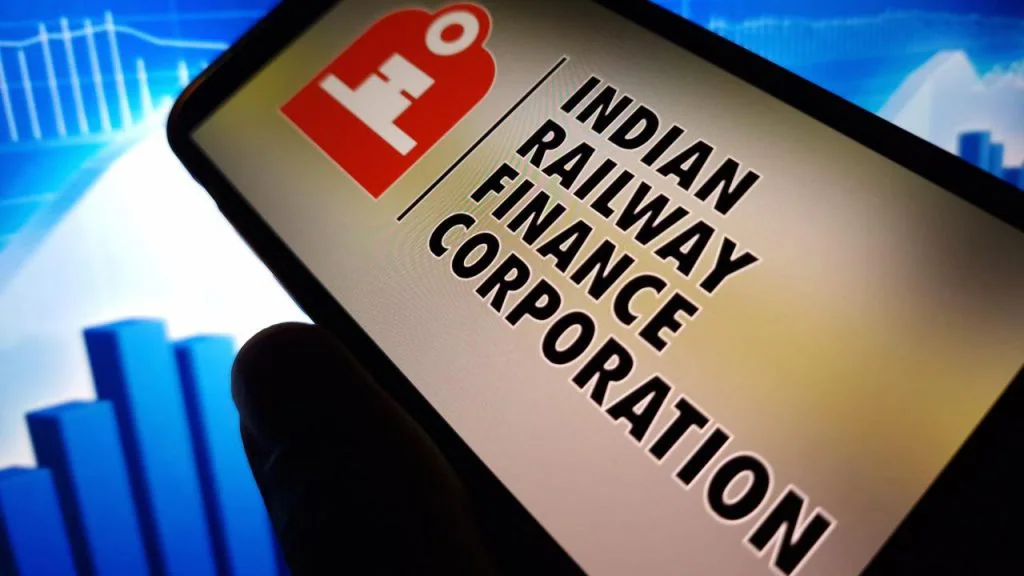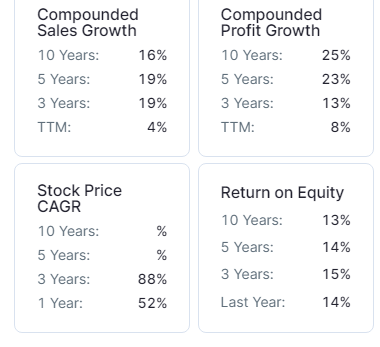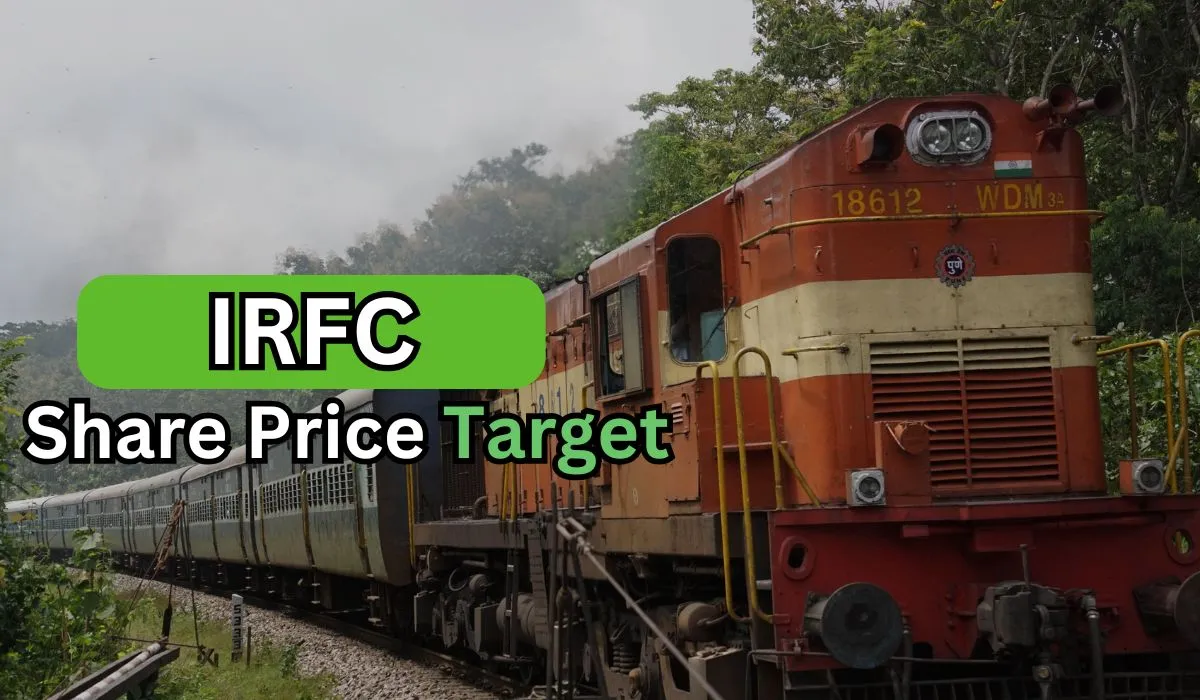Indian Railway Finance Corporation, commonly known as IRFC, was listed on the NSE on January 29, 2021, at a price of ₹24.90. Since listing, its stock has given a massive return of more than 400%. Will IRFC continue to provide such impressive returns in the future? Let’s explore the IRFC growth potential and the IRFC share price target from 2025 to 2050 in this article.
| Years | Target Price |
|---|---|
| IRFC Share Price Target 2025 | ₹160 to ₹195 |
| IRFC Share Price Target 2026 | ₹190 to ₹250 |
| IRFC Share Price Target 2027 | ₹240 to ₹330 |
| IRFC Share Price Target 2028 | ₹275 to ₹430 |
| IRFC Share Price Target 2029 | ₹340 to ₹550 |
| IRFC Share Price Target 2030 | ₹400 to ₹700 |
| IRFC Share Price Target 2035 | ₹750 to ₹1500 |
| IRFC Share Price Target 2040 | ₹1500 to ₹4000 |
| IRFC Share Price Target 2050 | ₹3500 to ₹9500 |
About IRFC

The Indian Railway Finance Corporation (IRFC) is a public sector company that raises funds for the Indian Railways from domestic and international markets by issuing bonds, loans, and financial instruments. It was established in December 1986 by the Ministry of Railways.
IRFC Business Model
- Loan Business: IRFC raises money from domestic and international markets and provides loans to Indian Railway companies such as Rail Vikas Nigam Limited (RVNL), Konkan Railway Corporation Limited, Rail Land Development Authority, and RailTel Corporation of India.
- Asset Leasing Business: IRFC leases assets like locomotives, passenger coaches, wagons, and other railway infrastructure to Indian Railways. It operates on long-term leasing agreements, providing predictable and stable cash flows, which ensures its consistent revenue.
IRFC Fundamental Analysis
| Stock Name | IRFC Ltd. |
|---|---|
| Market Cap | ₹ 1,64,598 Cr. |
| 52W High | ₹ 229 |
| 52W Low | ₹ 108 |
| Stock P/E (TTM) | 25.5 |
| Book Value | ₹ 39.4 |
| Dividend Yield | 1.00 % |
| ROCE | 5.83 % |
| ROE | 12.8 % |
| Face Value | ₹ 10.0 |
| Cash Reserves | ₹ 38,396 Cr. |
| Industry PE | 22.7 |
| Price to Book Value | 3.14 |
| Debt to Equity | 7.83 |
| PEG Ratio | 1.66 |
| Quick ratio | 20.6 |

| Share holder | March 2023 | March 2024 | March 2025 |
|---|---|---|---|
| Promoters | 86.36% | 86.36% | 86.36% |
| FIIs | 1.15% | 1.08% | 0.98% |
| DIIs | 2.62% | 0.89% | 1.34% |
| Public | 9.87% | 11.68% | 11.32% |
| No. of Shareholders | 16,34,919 | 45,26,341 | 56,35,775 |
Key Factors Driving IRFC Growth
- Government Push for Railway Modernization: The Government of India has set ambitious targets for railway electrification, high-speed rail projects (such as the bullet train initiative), replacement of old ICF coaches with LHB coaches, and expanded freight corridors. The IRFC will continue to play an important role in financing these projects, ensuring steady growth.
- Introduction of New Trains: Indian Railways is planning to deploy various new trains, such as Vande Bharat Chair Car and Sleeper trains, Namo Bharat Rapid Rail, and Amrit Bharat Train services. As IRFC is the only financier for these projects, this highlights IRFC’s promising growth.
- Focus on Green Energy and Electrification: The IRFC is expected to support sustainable projects such as railway electrification and green energy initiatives. This aligns with India’s goal of reaching net-zero emissions by 2070, creating new opportunities for financing environmentally friendly projects.
- Dedicated Freight Corridors (DFC): The Indian government sets a high priority on the development of dedicated freight corridors. These corridors will increase freight capacity, reduce passenger route congestion, and increase IRFC’s leasing and financing demand.
- Urban Transport and Metro Projects: IRFC may diversify into financing metro and urban transport systems, contributing to the growth of city-level infrastructure. This diversification can reduce dependency on Indian Railways and unlock new revenue streams.
Pros of IRFC
- Strong Profit Growth: IRFC has delivered a strong profit growth of 25% CAGR over 10 years.
- Increase in DIIs Holding: DIIs increased their holding from 1.24% in December 2024 to 1.34% in March 2025.
- Indian Government Support: IRFC is the financing arm of Indian Railways, a government entity, ensuring a strong foundation and lower risk.
- High Capex in the Coming Years: As the government focuses on expanding and modernizing railways, capital expenditure (capex) is expected to rise significantly, which will increase IRFC’s financing opportunities.
- Role in Railway Modernization: With Indian Railways focused on electrification, high-speed rail projects, and related infrastructure upgrades, IRFC’s role is expected to increase, benefiting its long-term growth prospects.
Cons of IRFC
- High Price to Book Value: IRFC’s stock is trading at a Price-to-Book Value (P/B) ratio of 3.14, which indicates that its stock is significantly overvalued compared to its book value.
- Low Return on Capital Employed (ROCE): IRFC’s 5-year average ROCE is 5.40%, which shows that IRFC is not using its capital efficiently to generate profits.
- Dependence on Indian Railways: IRFC’s revenue heavily depends on Indian Railways’ capital expenditure. A reduction in government spending on railways could have a negative impact on the company’s growth.
- High Financial Risk: IRFC has a high debt-to-equity ratio of 7.83, indicating a strong dependency on debt. This increases financial risk, raises interest costs, and may have an impact on profitability.
- Low Interest Coverage Ratio: The interest coverage ratio of IRFC is 1.32, which shows that the company is struggling to pay interest.
By the end of 2025, the IRFC share price is expected to be around ₹170 in normal conditions. In a bear market, it might be ₹160, and in a bull market, it may cross its 52-week high of ₹195.
| IRFC Share Price Target 2025 | Rupees (₹) |
|---|---|
| 1st Target | 160 |
| 2nd Target | 170 |
| 3rd Target | 195 |
In 2026, the IRFC share price is expected to be around ₹210 in a normal situation. In a bear market, it might be ₹190, and in a bull market, it may cross ₹250.
| IRFC Share Price Target 2026 | Rupees (₹) |
|---|---|
| 1st Target | 190 |
| 2nd Target | 210 |
| 3rd Target | 250 |
According to our analysis, the IRFC share price is expected to be around ₹275 in 2027. In a bear market, it might be ₹240, and in a bull market, it may cross ₹330.
| IRFC Share Price Target 2027 | Rupees (₹) |
|---|---|
| 1st Target | 240 |
| 2nd Target | 275 |
| 3rd Target | 330 |
According to our analysis, the IRFC share price may trade near ₹300 by 2028; bearish conditions could pull it down to ₹275, while a strong bull run might lift it to ₹430.
| IRFC Share Price Target 2028 | Rupees (₹) |
|---|---|
| 1st Target | 275 |
| 2nd Target | 300 |
| 3rd Target | 430 |
In a normal situation, the IRFC share price is projected to be approximately ₹400 in 2029. In a bear market, the value may be as low as ₹340, while in a bull market, it may rise to ₹550.
| IRFC Share Price Target 2029 | Rupees (₹) |
|---|---|
| 1st Target | 340 |
| 2nd Target | 400 |
| 3rd Target | 550 |
By 2030, the IRFC share price is projected to be around ₹500 under normal conditions. In adverse markets, the price could fall to ₹400, while favorable conditions might push it up to ₹700.
| IRFC Share Price Target 2030 | Rupees (₹) |
|---|---|
| 1st Target | 400 |
| 2nd Target | 500 |
| 3rd Target | 700 |
By 2035, the IRFC share price is projected to be around ₹950 under normal conditions. In adverse markets, the price could fall to ₹750, while favorable conditions might push it up to ₹1500.
| IRFC Share Price Target 2035 | Rupees (₹) |
|---|---|
| 1st Target | 750 |
| 2nd Target | 950 |
| 3rd Target | 1500 |
Under normal conditions, the IRFC share price might hit ₹2500 by 2040. A bearish trend could lower it to ₹1500, whereas a bullish surge could raise it to ₹4000.
| IRFC Share Price Target 2040 | Rupees (₹) |
|---|---|
| 1st Target | 1500 |
| 2nd Target | 2500 |
| 3rd Target | 4000 |
In 2050, the IRFC share price is expected to be around ₹5000 in a normal situation. In a bear market, it might be ₹3500, and in a bull market, it may go up to ₹9500.
| IRFC Share Price Target 2050 | Rupees (₹) |
|---|---|
| 1st Target | 3500 |
| 2nd Target | 5000 |
| 3rd Target | 9500 |
IRFC Quarterly Results
| Particulars | June 2024 | Sept 2024 | Dec 2024 | March 2025 |
|---|---|---|---|---|
| Sales | 6,766 | 6,900 | 6,764 | 6,723 |
| Expenses | 33 | 38 | 39 | 44 |
| Operating Profit | 6,733 | 6,862 | 6,724 | 6,679 |
| OPM % | 100% | 99% | 99% | 99% |
| Other Income | 0 | 1 | 3 | 1 |
| Interest | 5,155 | 5,249 | 5,095 | 4,996 |
| Depreciation | 2 | 1 | 1 | 1 |
| PBT | 1,577 | 1,613 | 1,631 | 1,682 |
| Tax % | 0% | 0% | 0% | 0% |
| Net Profit | 1,577 | 1,613 | 1,631 | 1,682 |
| EPS in Rs | 1.21 | 1.23 | 1.25 | 1.29 |
IRFC Balance Sheet
| Particulars | March 2023 | March 2024 | March 2025 |
|---|---|---|---|
| Equity Capital | 13,069 | 13,069 | 13,069 |
| Reserves | 31,612 | 36,110 | 39,599 |
| Borrowings | 418,935 | 412,039 | 412,133 |
| Other Liabilities | 26,744 | 23,865 | 24,034 |
| Total Liabilities | 490,359 | 485,082 | 488,835 |
| Fixed Assets | 19 | 22 | 21 |
| CWIP | 0 | 4 | 0 |
| Investments | 14 | 54 | 38 |
| Other Assets | 490,326 | 485,003 | 488,775 |
Conclusion
The future of the Indian Railway Finance Corporation appears bright due to its strong relationship with Indian Railways and the government. As the railway sector grows, IRFC will continue to benefit. While share price targets are speculative, IRFC remains a solid choice for long-term investment.
FAQ’s
What is IRFC?
Indian Railway Finance Corporation (IRFC) is a government-owned company that raises funds for Indian Railways by issuing bonds, loans, and financial instruments. It was established in December 1986.
The IRFC share price target for 2025 is estimated to be between ₹160 and ₹195, driven by increasing railway infrastructure investment, the introduction of new trains, and the company’s stable revenue model.
By 2030, IRFC’s share price is expected to be in the range of ₹400 to ₹700, supported by higher railway modernization, electrification projects, and steady financial growth.
IRFC’s share price target for 2035 is projected to be ₹750 to ₹1500, considering the expansion of freight corridors, metro financing, and increasing railway capital expenditure.
By 2040, IRFC’s share price could reach ₹1500 to ₹4000, as the company benefits from large-scale railway upgrades, new high-speed rail projects, and sustainable energy investments.
The IRFC share price for 2050 is expected to be in the range of ₹3500 to ₹9500, driven by long-term railway expansion, technological advancements, and its strong government-backed financial model.
Is IRFC a safe long-term investment?
IRFC’s business model, strong government linkages, and predictable income streams make it relatively safe for long-term investors. However, investors should consider the low capital efficiency and high debt levels before investing.
Disclaimer
This article is for educational purposes only. It is not a stock recommendation and should not be treated as such. Please ask your financial advisor before making any investment decision.
Also Read: Top Indian Railway Stocks in 2025

